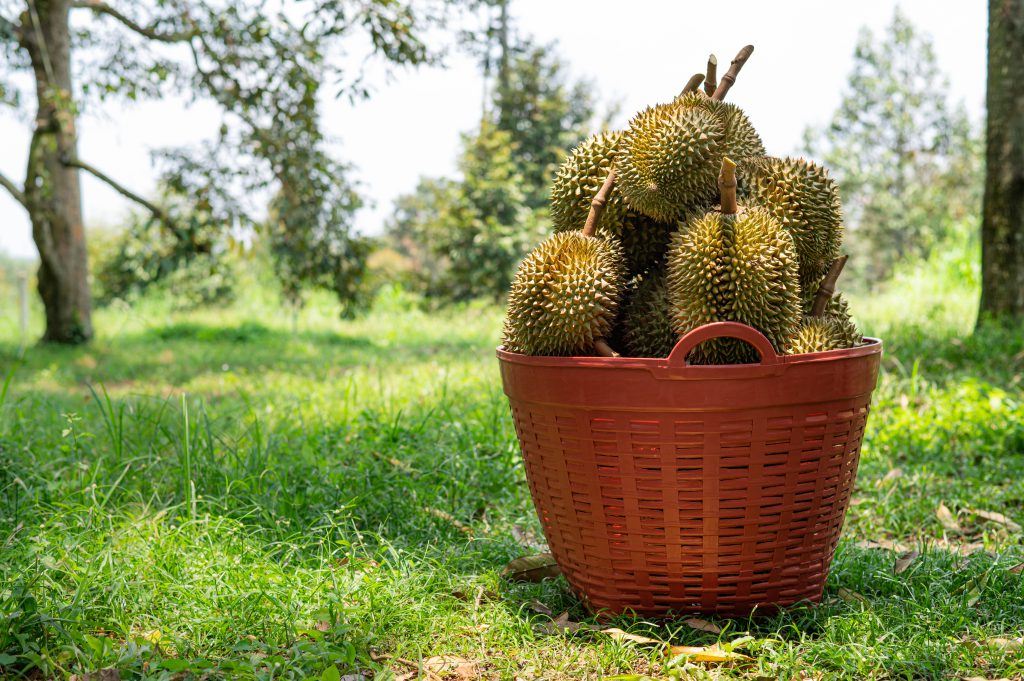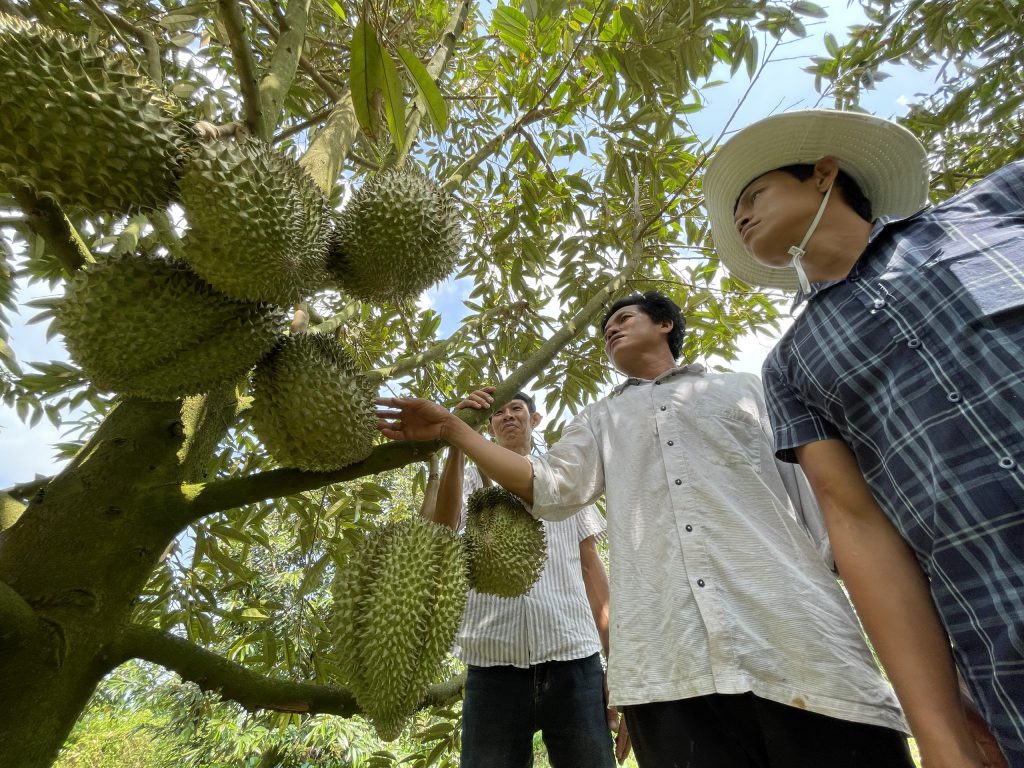Story: Quynh Thuong
In early 2020, people in Hanoi rushed to “rescue” durians, priced at only VND 450,000 per eight-kg box, due to export issues with China. However, nearly two years later, after being a fruit that was difficult to cultivate, care for, and sell, Vietnamese durians were granted an official export “visa” to China.
In 2023 alone, the export of this fruit achieved a record revenue of USD 2.1 billion, an increase of USD 1.82 billion compared to the previous year, accounting for 37.5% of the country’s total vegetable and fruit export revenue.

Impressive growth in a billion-strong market
The remarkable export growth of this “king of fruits” has raised Vietnam’s vegetable and fruit export turnover in 2023 to a record of nearly USD 5.7 billion, a nearly 70% increase compared to 2022, surpassing the target set earlier by the Ministry of Agriculture and Rural Development.
The latest data from China Customs also shows that China’s imports of durians from Vietnam increased by 1107% in volume and 1036% in value in 2023 compared to 2022. This is an unprecedented increase in the history of Vietnam’s durian industry.
Previously, Thailand was the only durian supplier to China, but its market share has been slipping due to the emergence of durians from Vietnam and Malaysia. By 2023, the market share of Thai durians in China decreased to 65.1%, while ones from Vietnam took 34.6% of the market.
The export turnover of Vietnamese durians has grown remarkably from over USD 100 million in 2021 to over USD 400 million in 2022 and to over USD 2 billion in 2023, following the official export agreement.
Statistics from the Ministry of Agriculture and Rural Development show that the area devoted to growing durians in Vietnam is estimated to reach 110,000 hectares in 2023, an increase of 24% compared to the previous year. The harvesting area is 54,400 hectares, with a yield of 16.5 tons per hectare and a total production of 849,100 tons.
Currently, Vietnamese durians are exported to eight countries, but exports to China alone account for up to 97% of the total export volume, and mainly involve fresh durians.
With a population of over 1.4 billion, China is increasingly becoming an attractive and essential “piece of the cake” for Vietnam’s agricultural producers. In 2023, this country ranked first in consumption of Vietnamese vegetables and fruits with an export turnover of USD 3.7 billion, a 149% increase compared to 2022 and accounting for more than 65% of the total vegetable and fruit export turnover.
Specifically for durians, statistics in 2023 showed that China’s import of durians continued to rise sharply, reaching 1.4 million tons, valued at USD 6.7 billion, an increase of 72.9% in volume and 65.6% in value compared to 2022. It is projected that by 2024, the import value of this fruit could reach USD 8 billion.

What are the advantages of Vietnam’s “king of fruits”?
Mr. Dang Phuc Nguyen, the General Secretary of the Vietnam Fruit and Vegetable Association, assesses that Vietnamese durians have the advantage of abundant production, with harvests all year round. It takes only about 1.5 days to transport durians from Vietnam’s fields to China, ensuring that the durians remain fresh and competitive with products from Thailand.
In addition, Vietnam’s logistics costs for exporting to the Chinese market are lower than Thailand’s, which helps Vietnamese durians to compete costwise with Thai durians in the Chinese market. In the future, the completion of the North-South Expressway will facilitate faster road transportation of durians to China.
Overall, Vietnamese durians are cheaper than Thai durians, thus serving the needs of a large number of Chinese consumers. In 2023, the average import price of durians from Vietnam was USD 4,332 per ton, while the average import price of durians from Thailand was USD 4,709 per ton.
“Currently, China is the world’s largest importer of the “king of fruits” because Chinese people are especially fond of this fruit, while domestic production is negligible. This is a major stepping stone for Vietnamese durians to penetrate further and conquer this market of more than 1.4 billion people,” shared the General Secretary of the Vietnam Fruit and Vegetable Association.
Mr. Nguyen added that the amount of durians imported from Southeast Asian countries still cannot meet China’s “enormous” demands. “Even if the output of the entire Southeast Asian region were doubled, it would still not be enough to meet Chinese people’s demand for durians,” he remarked.
Challenges for Vietnam’s durians
Currently, the multi-billion-dollar market in China, which has nearly 1.4 billion people, is not exclusive to Vietnam. Competitors in the race to export durians to China include Thailand, Malaysia, the Philippines, Cambodia, etc. However, according to Mr. Dang Phuc Nguyen, Thailand is the only real competitor to Vietnam in terms of its production volume.
“The biggest challenge for Vietnamese durians in the Chinese market now is quality control and protecting the Vietnamese durian brand,” he emphasized.
In reality, for over a year now, with the popularity of this “king of fruits,” many farmers and traders have been focusing on quantity, deliberately harvesting unripe durians or artificially ripening them for sale. This is a major reason for the decline in the quality of Vietnamese durians.
Citing the example of Thailand, Mr. Nguyen acknowledges that the quality and price of Thai durians, particularly the Monthong variety, are still higher than those from Vietnam due to tight controls by Thai regulatory agencies. “Despite the higher price, Chinese people still favour Thai durians because of their national brand reputation,” he said.
A reputation for consistent quality and an attractive appearance give Thai durians an edge in China, compared to those from newer rivals like Vietnam and Malaysia. Thai producers are constantly working to increase their competitiveness and maintain their market share in this market of over 1.4 billion people.
Even shipments from certified export-qualified plantations are re-examined at the border by Thai customs officials for quality. If the fruit do not meet the required standards, Thai customs staff can cancel the shipment or request that it be returned to maintain the reputation of the Thai durian brand. This management helps Thai durians to win the trust of Chinese consumers.
Besides durians, Mr. Nguyen also mentioned that Vietnam’s jackfruit has the potential for solid growth in the Chinese market. Specifically, in 2023, the export turnover of jackfruit increased by nearly 40% compared to 2022, while bananas and mangoes only saw growth of 2-3%.










